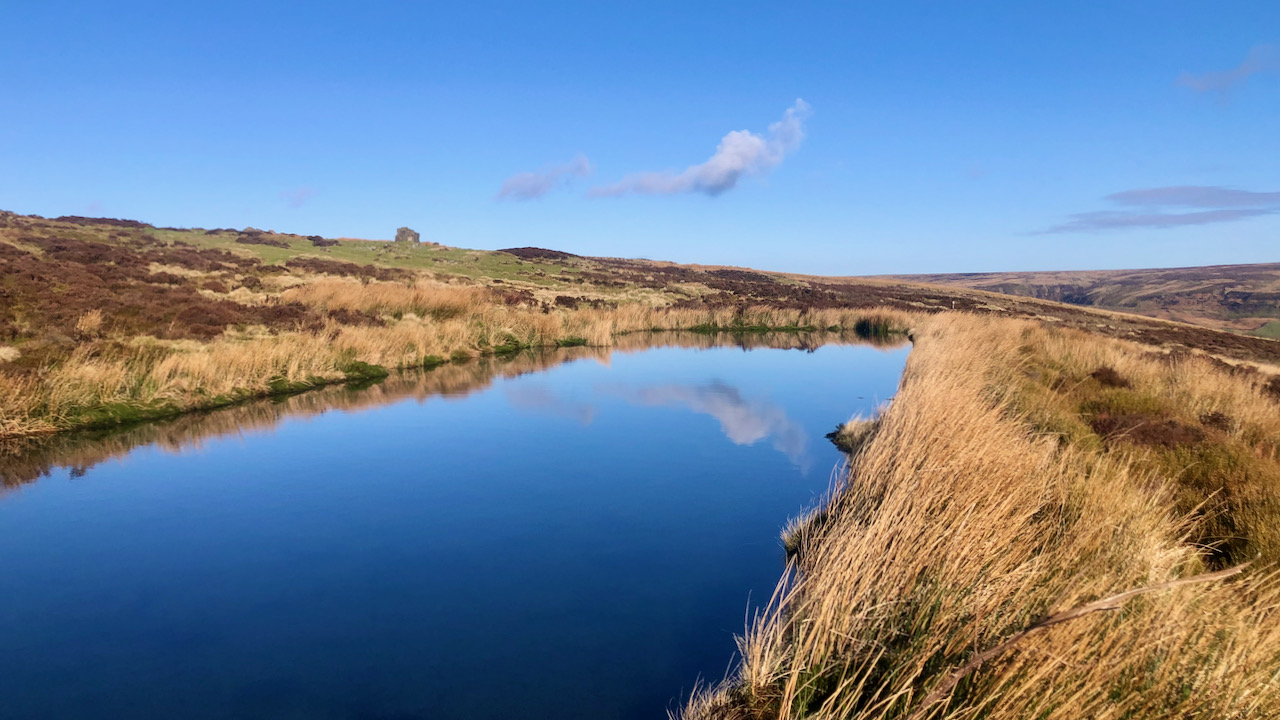Situated between Blakey Junction and the west calcining kilns, just before the Rosedale Abbey to Hutton-le-Hole road at Bank Top, there lies a small reservoir near the former farmstead of Sledge Shoe House, sustained by moorland springs.
Yet, it has been brought to my attention that this presents a puzzle.
It is acknowledged that the reservoir once served as a water source for the locomotives on the Rosedale ironstone railway. Sledge Shoe House, now entirely ruined, an isolated gable just apparent in the distance in the photograph, was where the railway worker lived who was responsible for the water provisioning1HAYES, R. H. & J. G. RUTTER. Page 21. “ROSEDALE MINES and RAILWAY.” 1996..
However, the conundrum lies because the 1857 Ordnance Survey Six-Inch map, surveyed between 1853 and 1854, shows the reservoir, yet makes no depiction of the railway or any of its related features.
Indeed, the railway did not officiate its opening until the 27th of March in the year 1861, when a special convoy of wagons transported the railway dignitaries, engineers, and contractors to Bank Top, whereupon “‘the workers were regaled on old English beef, bread and ale’’. Initial reports of an extensive field of ironstone in Rosedale hadn’t started circulating until August 18542‘Local and District News. | Newcastle Guardian and Tyne Mercury | Saturday 05 August 1854 | British Newspaper Archive’. 2024. Britishnewspaperarchive.co.uk <https://www.britishnewspaperarchive.co.uk/viewer/bl/0000366/18540805/015/0005> [accessed 24 February 2024].
So, what was the reservoir’s initial purpose?
My only, somewhat far-fetched, suggestion is that it could have been something to be with coal mining.
Across the North York Moors, coal was extracted over substantial areas of the high tops. The remains of these workings endure as shallow pits within mounds of the spoil. Most date from the 18th and 19th centuries, a time when the mining operations were principally conducted by family units. The area around Sledge Shoe House, extending perhaps two miles along Blakey Rigg, was part of such a coal-mining activity.
Curiously, in the latter part of that century, the Court Leet of the Manor of Spaunton imposed a fine of one shilling upon the N.E.R. for the reservoir at Little Blakey, ostensibly this one next to Sledge Shoe House. The significance of this eludes me, yet it implied that the company may have transgressed its entitlements, perhaps regarding the collection of water from the moor.
So, I would be interested if anyone has any other ideas of the original purpose for this reservoir.
- 1HAYES, R. H. & J. G. RUTTER. Page 21. “ROSEDALE MINES and RAILWAY.” 1996.
- 2‘Local and District News. | Newcastle Guardian and Tyne Mercury | Saturday 05 August 1854 | British Newspaper Archive’. 2024. Britishnewspaperarchive.co.uk <https://www.britishnewspaperarchive.co.uk/viewer/bl/0000366/18540805/015/0005> [accessed 24 February 2024]

Leave a Reply